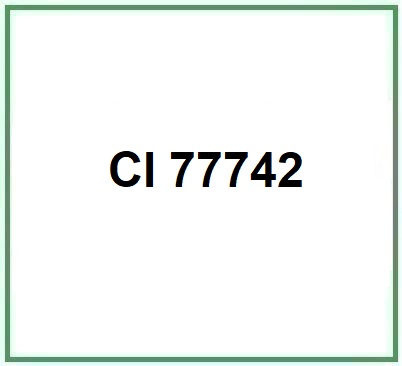CI 77742 is a chemical compound, known as ammonium manganese diphosphate or manganese violet, is chemically classified as an inorganic colorant. This pigment is widely used in various industrial and cosmetic applications due to its distinctive violet color and excellent stability.
Chemical Name
- Ammonium manganese(3+) diphosphate
Chemical Composition and Structure
CI 77742 is an inorganic compound with the chemical formula (NH4)MnP2O7. It consists of ammonium (NH4+), manganese (Mn3+), and diphosphate (P2O7) ions. This composition gives the pigment its characteristic violet color.
Physical Properties
This pigment typically appears as a fine violet powder. It has a high density and excellent covering power. CI 77742 is known for its chemical stability, resistance to light and heat, and inert nature, making it suitable for long-lasting applications. Its opacity and strong tinting strength make it a versatile pigment for various uses.
Chemical Industrial Synthesis Process
- Preparation of reagents. The main raw materials include manganese nitrate (Mn(NO₃)₂), ammonium phosphate ((NH₄)₂HPO₄), and water.
- Preparation of manganese nitrate solution. The manganese nitrate is dissolved in deionized water to form a manganese nitrate solution.
- Addition of ammonium phosphate. Ammonium phosphate is slowly added to the manganese nitrate solution with constant stirring. This reaction forms a precipitate of ammonium manganese phosphate.
- Formation of the precipitate. The solution is heated to about 90-100°C to promote the complete formation of the precipitate.
- Filtration. The resulting suspension is filtered to separate the solid precipitate from the aqueous solution.
- Washing. The precipitate is washed with deionized water to remove any soluble impurities.
- Drying. The washed precipitate is dried at controlled temperatures to remove residual moisture and obtain a dry powder.
- Calcination. The dried precipitate is calcined at a temperature of about 400-600°C to obtain the stable form of ammonium manganese phosphate.
- Grinding. The calcined product is ground to obtain a fine and uniform powder.
- Classification. The calcined powder is classified to ensure a uniform particle size. This step may involve sieving or the use of air classifiers.
- Stabilization. The CI 77742 powder is stabilized to ensure its stability during transportation and storage, preventing aggregation and degradation.
- Quality control. The CI 77742 undergoes rigorous quality testing to ensure it meets standards for purity, color intensity, and safety. These tests include chemical analysis, spectroscopy, and physical tests to determine particle size and rheological properties.
What it is used for and where
Cosmetics
Restricted cosmetic ingredient as IV/140 a Relevant Item in the Annexes of the European Cosmetics Regulation 1223/2009. Substance or ingredient reported:
- Ammonium manganese(3+) diphosphate
Cosmetics - INCI Functions
- Colorant. This ingredient has the function of colouring the solution in which it is inserted in a temporary, semi-permanent or permanent manner, either alone or in the presence of the complementary components added for colouring.
CI 77742 is used in cosmetic products such as eyeshadows, blushes, and lipsticks due to its intense violet color and high opacity. It provides long-lasting color.
Industrial Applications
Plastics and Polymers: This pigment is employed in the production of plastics and polymers to improve color uniformity and opacity (1). It is commonly used in products like packaging materials and consumer goods.
Ceramics and Glass: CI 77742 is used in the production of ceramics and glass to achieve stable violet colors. It is particularly valued for its resistance to high-temperature processes.
Inks: The pigment is also used in printing inks to produce intense violet colors, ensuring high-quality and durable prints.
Safety
CI 77742 is generally considered safe for use in consumer products when handled according to proper safety procedures. It is important to avoid inhalation of the powder and minimize direct contact with skin and eyes.
Molecular Formula H4MnNO7P2
Molecular Weight 246.92 g/mol
CAS 10101-66-3
EC number 233-257-4
UNII 72M48QQV8Q
DTXSID70889526
Synonyms:
Manganese Violet
Pigment Violet 16
CI 77742
Nuremberg Violet
Bibliografia__________________________________________________________________________
(1) Nguyen, D. K., Bach, Q. V., Lee, J. H., & Kim, I. T. (2018). Synthesis and irreversible thermochromic sensor applications of manganese violet. Materials, 11(9), 1693.
Abstract. An irreversible thermochromic material based on manganese violet (MnNH4P2O7) is synthesized. The crystal phase, chemical composition, and morphology of the synthesized material are analyzed using X-ray diffraction, scanning electron microscopy coupled with energy-dispersive X-ray spectrometry, and Fourier-transform infrared spectroscopy. The absorption spectra of the synthesized material are obtained using a UV-Vis spectrometer, and the thermochromism exhibited by the powdered samples at high temperatures is also investigated. The as-synthesized manganese violet pigment consists of pure α-MnNH4P2O7 phase. In addition, the synthesized pigment largely consists of hexagonal crystals with a diameter of hundreds of nanometers. On heating, the pigment simultaneously loses H2O and NH3 in two successive steps at approximately 330–434.4 °C and 434.4–527 °C, which correspond to the formation of an intermediate phase and of Mn2P4O12, respectively. An overall mass loss of 14.22% is observed, which is consistent with the expected 13.79%. An irreversible color change from violet to white is observed after exposure of the synthesized manganese violet pigment at 400 °C for 30 min. This is attributed to the oxidation of ammonia to hydroxylamine, which then decomposes to nitrogen and water, or alternatively to the direct oxidation of ammonia to nitrogen. Furthermore, we demonstrate the potential application of synthesized manganese violet in the production of irreversible thermochromic paint by mixing with potassium silicate solution as a binder and deionized water as a solvent at a specific ratio. The thermochromic paint is then applied in fabrication of irreversible thermochromic sensors by coating it onto a steel plate surface. Finally, we show that manganese violet-based irreversible thermochromic sensors are able to detect temperatures around 400 °C by changing color from violet to white/milky.
![]() CI 77742
CI 77742 




